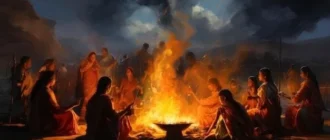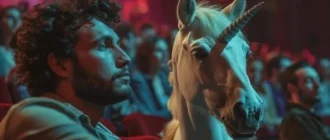Art is a universal language, a timeless testament to human creativity and expression. From the earliest cave paintings to the digital art of today, it reflects our evolving understanding of the world, ourselves, and the very essence of existence. This article embarks on a captivating journey through the annals of art history, exploring key periods, movements, and their defining characteristics.
Prehistoric Art: The Dawn of Creativity (40٫000 ‒ 4٫000 BC)
The earliest evidence of human artistic endeavors dates back to the Paleolithic era, a period marked by the creation of cave paintings, engravings, and sculptures. These works, often found deep within caves, provide invaluable insights into the lives, beliefs, and rituals of our ancestors.
The Paleolithic Era (2.5 Million ─ 12٫000 Years Ago)
- Cave Paintings: The most renowned examples of Paleolithic art are the awe-inspiring cave paintings found in Lascaux, France, and Altamira, Spain. These paintings, depicting animals, hunting scenes, and abstract patterns, showcase an astonishing level of skill and artistic sensibility.
- Portable Art: In addition to cave paintings, Paleolithic artists also created small, portable sculptures known as “Venus figurines.” These figurines, often depicting voluptuous female forms, are believed to have been associated with fertility and abundance.
The Mesolithic Era (12,000 ‒ 8,000 Years Ago)
- Shift in Focus: With the retreat of the glaciers and the emergence of new environments, Mesolithic art reflected a shift in human focus towards smaller, more agile prey. This is evident in the rock art of this period, which often features stylized depictions of deer, birds, and fish.
- Abstraction and Symbolism: Mesolithic art also saw a rise in the use of abstract symbols and geometric patterns. These symbols, whose meanings remain largely enigmatic, likely held cultural and spiritual significance for the communities that created them.
The Neolithic Era (8,000 ─ 4,000 BC)
- The Rise of Agriculture: The Neolithic Revolution, marked by the advent of agriculture and settled life, brought about profound changes in human society and, consequently, art. Neolithic art reflects these changes, with a growing emphasis on domestic scenes, agricultural practices, and the human form.
- Megalithic Structures: The Neolithic era also witnessed the construction of monumental stone structures known as megaliths. Stonehenge in England and Newgrange in Ireland are iconic examples of these enigmatic structures, believed to have served astronomical, religious, and social purposes.
Ancient Art: Civilizations of Grandeur (4,000 BC ─ 500 AD)
The rise of civilizations in Mesopotamia, Egypt, Greece, and Rome ushered in a new era of artistic innovation. Ancient art is characterized by its grandeur, technical mastery, and profound religious and political symbolism.
Mesopotamian Art (3500 ─ 539 BC)
- Cuneiform Writing: The Sumerians, inhabitants of ancient Mesopotamia, developed a writing system known as cuneiform. This system, using wedge-shaped marks impressed on clay tablets, was used to record everything from religious texts to commercial transactions.
- Ziggurats and Temples: Mesopotamian architecture was dominated by massive temples known as ziggurats. These stepped pyramids, dedicated to the city’s patron deity, served as both religious and administrative centers.
Egyptian Art (3000 ‒ 30 BC)
- Pyramids and Tombs: Egyptian art is synonymous with the colossal pyramids and elaborate tombs of its pharaohs; These structures, adorned with hieroglyphics and intricate carvings, were intended to ensure the safe passage of the deceased into the afterlife.
- Hieroglyphics: The Egyptians developed a sophisticated writing system using hieroglyphs ─ pictorial symbols representing words, sounds, and concepts. Hieroglyphics were used for a wide range of purposes, from religious texts to tomb decorations.
Greek Art (850 ‒ 31 BC)
- Idealized Human Form: Greek art is celebrated for its pursuit of perfection and harmony. Greek sculptors mastered the art of depicting the human form in its ideal state, emphasizing balance, proportion, and naturalism.
- Temples and Theaters: Greek architecture, characterized by its use of columns, pediments, and friezes, continues to inspire awe and admiration. The Parthenon in Athens stands as an enduring testament to the architectural genius of the ancient Greeks.
Roman Art (509 BC ─ 476 AD)
- Realism and Practicality: Roman art, while influenced by Greek traditions, developed its own distinct characteristics. Roman artists placed a greater emphasis on realism and practicality, as evidenced in their portrait sculptures, mosaics, and frescoes.
- Engineering Marvels: The Romans were master engineers, renowned for their innovative use of arches, vaults, and concrete. The Colosseum in Rome and the Pont du Gard in France are testaments to their architectural prowess.
Medieval Art: Faith and Form (500 ─ 1400)
The Middle Ages, a period spanning nearly a millennium, saw the rise of Christianity and the decline of the Roman Empire. Medieval art reflects the religious fervor of the era, with a focus on biblical narratives, saints, and the afterlife.
Byzantine Art (330 ─ 1453)
- Icons and Mosaics: Byzantine art is characterized by its shimmering mosaics, intricate icons, and stylized figures. These works, often imbued with religious symbolism, adorned the walls of churches and monasteries throughout the Byzantine Empire.
- Hagia Sophia: The Hagia Sophia in Istanbul, originally built as a Christian cathedral, is a masterpiece of Byzantine architecture. Its soaring dome and intricate mosaics continue to captivate visitors from around the world.
Romanesque Art (1000 ─ 1200)
- Massive Churches and Monasteries: Romanesque art emerged during a period of church building across Europe. Romanesque churches, characterized by their thick walls, round arches, and small windows, exude a sense of solidity and permanence.
- Sculptural Reliefs: Romanesque sculpture, often found adorning church portals, is characterized by its stylized figures, biblical narratives, and Last Judgment scenes.
Gothic Art (1140 ─ 1400)
- Soaring Cathedrals: Gothic architecture, with its pointed arches, ribbed vaults, and flying buttresses, allowed for the construction of taller, lighter, and more awe-inspiring cathedrals. The stained glass windows of Gothic cathedrals, filled with biblical stories and saintly figures, bathed the interiors in a kaleidoscope of colors.
- Naturalism and Emotion: Gothic sculpture and painting exhibit a growing interest in naturalism and the expression of human emotion. The figures in Gothic art, while still stylized, appear more lifelike and relatable than their Romanesque predecessors.
The Renaissance: Rebirth and Revolution (1400 ─ 1600)
The Renaissance, meaning “rebirth,” marked a period of renewed interest in classical art, literature, and philosophy. Renaissance artists, inspired by the achievements of ancient Greece and Rome, sought to revive classical ideals of beauty, harmony, and humanism.
Early Renaissance (1400 ─ 1500)
- Florence, the Cradle of the Renaissance: The Early Renaissance flourished in Florence, Italy, under the patronage of wealthy families like the Medici. Artists like Donatello, Masaccio, and Botticelli led the way in reviving classical techniques and exploring new approaches to perspective and realism.
- Humanism: Humanism, a philosophical movement that emphasized the value and agency of human beings, played a pivotal role in shaping Renaissance art. Renaissance artists celebrated the human form, intellect, and potential.
High Renaissance (1500 ─ 1527)
- The Golden Age of Italian Art: The High Renaissance witnessed the pinnacle of Italian Renaissance art, with Leonardo da Vinci, Michelangelo, and Raphael emerging as titans of the era. Their masterpieces, including the Mona Lisa, the Sistine Chapel ceiling, and The School of Athens, continue to inspire awe and wonder.
- Technical Mastery and Emotional Depth: High Renaissance art is characterized by its technical brilliance, anatomical accuracy, and emotional depth. Artists like Leonardo da Vinci explored the nuances of human expression, capturing subtle emotions and psychological complexity in their portraits.
Late Renaissance (1527 ─ 1600)
- Mannerism: The Late Renaissance saw the emergence of Mannerism, a style characterized by elongated figures, exaggerated poses, and a sense of artificiality. Mannerist artists, such as El Greco and Pontormo, rejected the harmonious ideals of the High Renaissance, favoring more expressive and experimental approaches.
- Spread of Renaissance Ideals: Renaissance ideas and artistic styles spread beyond Italy, influencing artists throughout Europe. Albrecht Dürer in Germany, Pieter Bruegel the Elder in Flanders, and El Greco in Spain made significant contributions to the Northern Renaissance.
The Baroque: Drama, Opulence, and Emotion (1600 ─ 1750)
The Baroque era, characterized by drama, opulence, and emotional intensity, emerged as a reaction against the restrained elegance of the Renaissance. Baroque art sought to evoke awe and wonder, often employing dramatic lighting, theatrical compositions, and lavish ornamentation.
Caravaggio and Tenebrism:
- Chiaroscuro: Italian painter Caravaggio revolutionized Baroque painting with his dramatic use of chiaroscuro ‒ a technique that contrasted stark shadows with brilliant light to create a sense of volume and theatricality.
- Religious and Genre Scenes: Caravaggio’s paintings, often depicting religious scenes or everyday life, were infused with a raw realism and emotional intensity that captivated viewers.
Bernini and Baroque Sculpture:
- Dynamic Movement and Emotion: Italian sculptor Gian Lorenzo Bernini breathed life into marble, creating sculptures that seemed to pulsate with movement and emotion. His masterpiece, The Ecstasy of Saint Teresa, captures the saint’s mystical experience with breathtaking realism.
- Architectural Projects: Bernini was also a renowned architect, designing the magnificent piazza and colonnade in front of St. Peter’s Basilica in Rome.
Rembrandt and Dutch Golden Age Painting:
- Psychological Depth: Dutch painter Rembrandt van Rijn was a master of light and shadow, using chiaroscuro to create portraits of remarkable psychological depth. His self-portraits, spanning his career, offer a poignant glimpse into the artist’s soul.
- Genre Scenes and Landscapes: The Dutch Golden Age witnessed a flourishing of genre painting, depicting scenes from everyday life. Artists like Johannes Vermeer and Frans Hals captured the beauty of ordinary moments with remarkable skill.

The Enlightenment and Neoclassicism: Reason and Order (1700 ‒ 1800)
The Enlightenment, an intellectual and philosophical movement that emphasized reason, logic, and empirical observation, had a profound impact on the arts. Neoclassicism, inspired by the art and culture of ancient Greece and Rome, emerged as the dominant artistic style of the era.
Jacques-Louis David: Painter of the Revolution:
- Moral Clarity and Civic Virtue: French painter Jacques-Louis David embraced the ideals of the French Revolution, creating works that celebrated civic virtue, patriotism, and moral clarity. His masterpiece, The Oath of the Horatii, became an icon of the Revolution.
- Neoclassical Style: David’s paintings exemplified the Neoclassical style, with their balanced compositions, restrained emotions, and idealized figures.
Angelica Kauffman: A Trailblazing Woman Artist:
- History Painting: Angelica Kauffman, a Swiss-Austrian painter, achieved international acclaim for her history paintings, a genre traditionally dominated by men. Her works often depicted scenes from classical mythology and literature, infused with grace, emotion, and a touch of Romanticism.
- Royal Academy of Arts: Kauffman was one of only two women founding members of the Royal Academy of Arts in London.
Thomas Jefferson: Architect of a New Nation:
- Palladian Architecture: Thomas Jefferson, the third president of the United States, was a passionate advocate for Neoclassical architecture. He designed his own home, Monticello, and the Virginia State Capitol in the Palladian style, inspired by the architecture of ancient Rome.
- Symbolism and Democracy: Jefferson’s architectural designs reflected his belief in the principles of democracy, reason, and the pursuit of knowledge.

Romanticism: Emotion, Imagination, and the Sublime (1780 ‒ 1850)
Romanticism, a reaction against the Enlightenment’s emphasis on reason and order, celebrated emotion, imagination, and the power of the natural world. Romantic artists sought to evoke awe, wonder, and a sense of the sublime.
Francisco Goya: Chronicler of History and the Human Condition:
- Spanish Master: Francisco Goya, a Spanish painter and printmaker, captured the tumultuous events of his time, including the Spanish Inquisition and the Napoleonic Wars, with unflinching honesty.
- Darker Side of Human Nature: Goya’s works explored the darker side of human nature, depicting violence, madness, and the grotesque with chilling realism.
Caspar David Friedrich: Painter of the Sublime:
- German Romantic Landscape Painter: Caspar David Friedrich, a German Romantic landscape painter, sought to capture the awe-inspiring power of nature in his paintings. His works often feature solitary figures contemplating vast landscapes, evoking a sense of wonder and the sublime.
- Symbolism and Spirituality: Friedrich’s paintings are imbued with symbolism, often exploring themes of spirituality, mortality, and the relationship between humanity and the natural world.
William Blake: Visionary Poet and Artist:
- English Poet and Printmaker: William Blake, an English poet, painter, and printmaker, was a visionary artist who explored themes of religion, mythology, and the power of imagination.
- Mystical and Symbolic Imagery: Blake’s works are characterized by their mystical imagery, vibrant colors, and symbolic language, often drawing inspiration from the Bible, Milton, and his own vivid imagination.
Realism and Impressionism: Capturing the Everyday (1840 ‒ 1900)
The mid-19th century witnessed a shift towards realism in art٫ with artists seeking to depict the world around them with greater accuracy and objectivity. Impressionism٫ a revolutionary art movement that emerged in France٫ sought to capture the fleeting effects of light and atmosphere.
Gustave Courbet: Champion of Realism:
- French Realist Painter: Gustave Courbet, a French painter, rejected the idealized subjects and romanticized scenes of traditional art, choosing instead to depict the everyday lives of ordinary people.
- Social Commentary: Courbet’s paintings often carried social and political messages, challenging viewers to confront the realities of poverty, inequality, and social injustice.
Édouard Manet: A Bridge Between Realism and Impressionism:
- French Modern Painter: Édouard Manet, a French painter, bridged the gap between Realism and Impressionism, incorporating elements of both movements into his work.
- Scandal and Innovation: Manet’s paintings, with their bold brushstrokes, flattened perspective, and unconventional subject matter, often sparked controversy but also paved the way for the Impressionist revolution.
Claude Monet: Master of Light and Impressionism:
- Founder of French Impressionist Painting: Claude Monet, a founder of French Impressionist painting, dedicated his career to capturing the fleeting effects of light and atmosphere. His iconic series of Water Lilies paintings, created in his garden at Giverny, are masterpieces of Impressionism.
- En Plein Air Painting: Monet and his fellow Impressionists embraced the practice of painting en plein air ─ outdoors, directly from nature ‒ to capture the immediacy of their subjects.
Modern Art: A World Transformed (1860 ‒ 1970)
The late 19th and early 20th centuries witnessed an unprecedented period of artistic innovation, as artists broke away from traditional conventions and explored new ways of seeing and representing the world. Modern art movements reflected the rapid social, technological, and intellectual changes of the era.
Post-Impressionism: Beyond Impressionism (1880s ‒ 1900s)
- Diverse Reactions to Impressionism: Post-Impressionism was not a unified movement but rather a term used to describe the diverse reactions to Impressionism. Artists like Paul Cézanne, Vincent van Gogh, and Paul Gauguin explored new avenues in form, color, and expression.
- Building Blocks for Modern Art: Post-Impressionism laid the groundwork for the development of modern art movements like Fauvism, Expressionism, and Cubism.
Fauvism: Wild Beasts of Color (1905 ‒ 1908)
- Bold Colors and Expressive Power: Fauvism, named for the French phrase “les fauves” (wild beasts), was a short-lived but influential art movement characterized by its bold use of color and expressive brushstrokes.
- Henri Matisse: Leading Figure of Fauvism: Henri Matisse, the leading figure of Fauvism, believed that color should be used to express emotions and create a sense of joy and liberation.
Expressionism: Inner Turmoil and Emotional Intensity (1905 ‒ 1920s)
- Emotional Experience over Reality: Expressionism, which emerged in Germany, emphasized the artist’s inner experience and emotional response to the world, often distorting forms and using jarring colors to convey feelings of anxiety, alienation, and despair.
- Edvard Munch and Ernst Ludwig Kirchner: Key Expressionist Artists: Edvard Munch’s iconic painting The Scream, with its swirling brushstrokes and contorted figure, epitomizes the Expressionist style. Ernst Ludwig Kirchner, a founder of the Die Brücke group, explored themes of urban alienation and social isolation.
Cubism: Fragmentation and Multiple Perspectives (1907 ─ 1920s)
- Revolutionizing Form and Perspective: Cubism, pioneered by Pablo Picasso and Georges Braque, revolutionized Western painting by breaking down objects and figures into geometric shapes and reassembling them in abstract forms.
- Multiple Perspectives: Cubist paintings often presented multiple perspectives simultaneously, challenging traditional notions of space and depth.
Surrealism: Exploring the Unconscious Mind (1920s ‒ 1950s)
- Dreamlike Imagery and Unconscious Mind: Surrealism, a movement that embraced the irrational and the unconscious, sought to unlock the power of the imagination by tapping into the world of dreams, fantasies, and hallucinations.
- Salvador Dalí and René Magritte: Iconic Surrealist Artists: Salvador Dalí’s melting clocks and bizarre dream-inspired imagery epitomize Surrealism. René Magritte challenged viewers’ perceptions of reality with his witty and thought-provoking paintings.
Abstract Expressionism: The Triumph of Gesture and Emotion (1940s ─ 1950s)
- Post-World War II Art Movement: Abstract Expressionism, which emerged in New York City after World War II, marked a significant shift in the art world, moving away from representation towards abstraction and pure expression.
- Action Painting and Color Field Painting: Abstract Expressionism encompassed a range of styles, including the gestural brushstrokes of Jackson Pollock’s action painting and the large fields of color in Mark Rothko’s work.
Contemporary Art: A World of Possibilities (1970 ‒ Present)
Contemporary art encompasses a vast and ever-evolving range of styles, media, and concepts, reflecting the complexities and diversity of the contemporary world. Artists continue to push the boundaries of artistic expression, exploring new technologies, engaging with social and political issues, and challenging traditional notions of what constitutes art.
Pop Art: Challenging High Art and Embracing Popular Culture (1950s ‒ 1970s)
- Blurring the Lines Between High Art and Popular Culture: Pop art emerged in the 1950s as a reaction against the elitism of Abstract Expressionism, embracing imagery from popular culture, advertising, and mass media.
- Andy Warhol and Roy Lichtenstein: Pop Art Icons: Andy Warhol’s iconic Campbell’s Soup Cans and Marilyn Monroe portraits elevated everyday objects and celebrities to the status of high art. Roy Lichtenstein’s paintings, inspired by comic books and advertising, explored the language of popular culture.
Conceptual Art: The Idea as Art (1960s ─ 1970s)
- Primacy of the Idea: Conceptual art challenged traditional notions of art by prioritizing the idea or concept behind the work over its material form or aesthetic qualities.
- Sol LeWitt and Joseph Kosuth: Key Conceptual Artists: Sol LeWitt’s wall drawings, executed according to a set of instructions, shifted the focus from the artist’s hand to the underlying concept. Joseph Kosuth’s word-based works explored the nature of language and representation.
Postmodernism: Questioning Grand Narratives and Embracing Pluralism (1970s ─ Present)
- Rejection of Universal Truths: Postmodernism, a complex and multifaceted movement, rejected the idea of universal truths and grand narratives, embracing pluralism, subjectivity, and the fragmentation of experience.
- Cindy Sherman and Jeff Koons: Postmodernist Artists: Cindy Sherman’s photographic self-portraits explored the construction of identity and the role of images in contemporary society. Jeff Koons challenged notions of taste and consumerism with his kitsch-inspired sculptures.
Digital Art: New Media and the Digital Age (1980s ‒ Present)
- Art and Technology: Digital art encompasses a wide range of artistic practices that utilize digital technologies, including computer graphics, animation, virtual reality, and the internet.
- Nam June Paik and Bill Viola: Pioneers of Video Art: Nam June Paik, a pioneer of video art, transformed television screens into canvases for artistic expression. Bill Viola’s immersive video installations explore themes of life, death, and the human condition.

Conclusion: A Legacy of Creativity
From the earliest cave paintings to the digital art of today, the history of art is a testament to the boundless creativity and imagination of the human spirit. As we’ve journeyed through the ages, exploring key periods, movements, and artists, we’ve witnessed the evolution of artistic expression, reflecting changing worldviews, cultural values, and technological advancements. Art continues to inspire, challenge, and provoke, reminding us of the power of human creativity to illuminate our world and shape our understanding of ourselves and the universe we inhabit.










